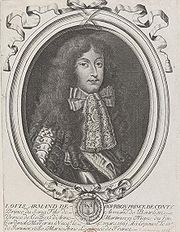
Louis Armand I, Prince of Conti
Encyclopedia

Fontainebleau
Fontainebleau is a commune in the metropolitan area of Paris, France. It is located south-southeast of the centre of Paris. Fontainebleau is a sub-prefecture of the Seine-et-Marne department, and it is the seat of the arrondissement of Fontainebleau...
) was Prince of Conti
Prince of Conti
The title of Prince of Conti was a French noble title, assumed by a cadet branch of the house of Bourbon-Condé. It was taken from Conty, a small town of northern France, c. 35 km southwest of Amiens, which came into the Condé family by the marriage of Louis of Bourbon, first prince of Condé,...
from 1666 to his death, succeeding his father, Armand de Bourbon. As a member of the reigning House of Bourbon
House of Bourbon
The House of Bourbon is a European royal house, a branch of the Capetian dynasty . Bourbon kings first ruled Navarre and France in the 16th century. By the 18th century, members of the Bourbon dynasty also held thrones in Spain, Naples, Sicily, and Parma...
, he was a Prince du Sang
Prince du Sang
A prince of the blood was a person who was legitimately descended in the male line from the monarch of a country. In France, the rank of prince du sang was the highest held at court after the immediate family of the king during the ancien régime and the Bourbon Restoration...
.
Louis Armand was born in Paris
Paris
Paris is the capital and largest city in France, situated on the river Seine, in northern France, at the heart of the Île-de-France region...
. In 1680 he married Marie Anne de Bourbon
Marie Anne de Bourbon
Marie Anne de Bourbon, Légitimée de France was the eldest legitimised daughter of King Louis XIV of France and Louise de La Vallière. At the age of thirteen, she was married to Louis Armand de Bourbon, Prince of Conti and as such was the Princess of Conti by marriage...
, the illegitimate daughter of King Louis XIV
Louis XIV of France
Louis XIV , known as Louis the Great or the Sun King , was a Bourbon monarch who ruled as King of France and Navarre. His reign, from 1643 to his death in 1715, began at the age of four and lasted seventy-two years, three months, and eighteen days...
and his first mistress, Louise de la Vallière
Louise de La Vallière
Louise de La Vallière was a mistress of Louis XIV of France from 1661 to 1667. She later became the Duchess of La Vallière and Duchess of Vaujours in her own right...
. The bride and groom were respectively thirteen and fifteen years old at the time. Since neither of them had been instructed on what to expect on their first night together, it ended up in disaster with the young princess fleeing in despair and the prince not wanting to share the bed of a woman again.
He served with distinction in Flanders
Flanders
Flanders is the community of the Flemings but also one of the institutions in Belgium, and a geographical region located in parts of present-day Belgium, France and the Netherlands. "Flanders" can also refer to the northern part of Belgium that contains Brussels, Bruges, Ghent and Antwerp...
in 1683, and, against the wish of the king, went to Hungary
Hungary
Hungary , officially the Republic of Hungary , is a landlocked country in Central Europe. It is situated in the Carpathian Basin and is bordered by Slovakia to the north, Ukraine and Romania to the east, Serbia and Croatia to the south, Slovenia to the southwest and Austria to the west. The...
, where he helped the Imperialists defeat the Turks at Gran in the same year. He died in Fontainebleau
Fontainebleau
Fontainebleau is a commune in the metropolitan area of Paris, France. It is located south-southeast of the centre of Paris. Fontainebleau is a sub-prefecture of the Seine-et-Marne department, and it is the seat of the arrondissement of Fontainebleau...
from smallpox
Smallpox
Smallpox was an infectious disease unique to humans, caused by either of two virus variants, Variola major and Variola minor. The disease is also known by the Latin names Variola or Variola vera, which is a derivative of the Latin varius, meaning "spotted", or varus, meaning "pimple"...
which he contracted from his wife. While she recovered after some time, the prince succumbed after five days.
Having no descendants, he was succeeded as Prince of Conti by his younger brother, François Louis de Bourbon
François Louis, Prince of Conti
François Louis de Bourbon, Prince of Conti was Prince de Conti, succeeding his brother Louis Armand I, Prince of Conti in 1685. Until this date he used the title of Prince of La Roche-sur-Yon. He was son of Armand de Bourbon and Anne Marie Martinozzi, niece of Cardinal Jules Mazarin...
(1664–1709).

